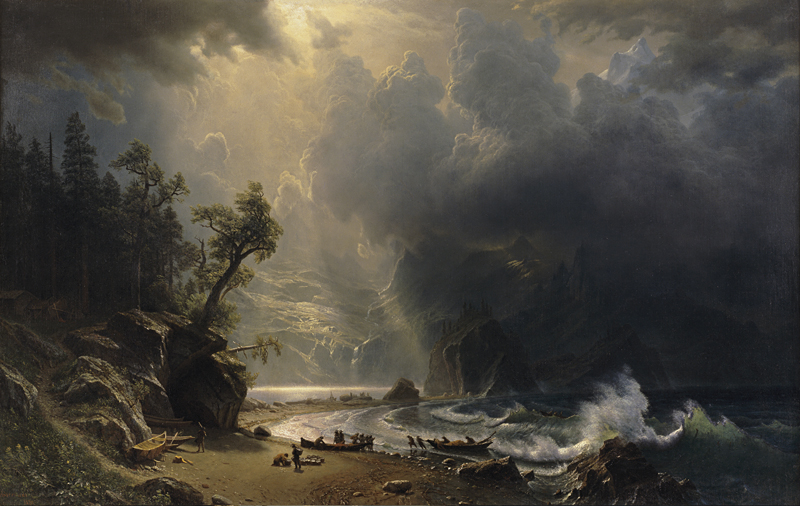Gas is expensive and the economy sour, so maybe you won’t be driving the family to Yellowstone this year. Or perhaps you’re even too busy at work to go hiking at Mount Rainier. Fortunately, there are closer options downtown. Two ongoing shows at SAM consider the American landscape from euphoric discovery to postindustrial disenchantment. The bigger, Bierstadt-laden exhibit is grandiosely titled Beauty & Bounty: American Art in an Age of Exploration. The smaller sidebar, which chronologically and conceptually follows it (essentially as your exit path) goes by Reclaimed: Nature & Place Through Contemporary Eyes. All of this can be more easily summarized as Before/After.
Before, once the Indians were safely contained and the land grabbed from beneath their moccasins, American settlers gradually became American tourists. The Civil War was over, the transcontinental railroad was complete (in 1869), and East Coast easels were packed for the wild American West. Some artists were likely tired of rendering the same old Hudson River scenes; others, like Thomas Moran and photographer Frank Jay Haynes, had their travels supported by railroad barons eager to inspire new passengers and settlers.
The biggest names—Moran, Albert Bierstadt, Sanford Gifford—enjoyed the best, first views of this new aesthetic terrain in Yosemite, Yellowstone, and the Columbia River Valley. Or, put differently: They were the first to sell and popularize them back East. Paintings are commodities, just as much as coal, timber, and fish. SAM’s late–19th century “before” artists are, in their way, in the business of resource extraction—using paint, brush, and early cameras as the tools to convey/capture something suddenly realized to be valuable.
After, once the forests were cut, the gold panned, and the freeways and suburbs built, a postwar generation of artists began to wonder where that value had gone. The landscape was changed, no longer strange and new, and a romantic view of nature no longer seemed possible. (Indeed, it might seem ridiculous.) What was left but stumps and mining rubble, ghost towns and rusting railroad tracks? The mountains might still have their grandeur—but after Ansel Adams, what’s the point? SAM’s “after” artists are working with scraps and remnants, not virgin materials and views.
The loop through “Beauty & Bounty” is essentially chronological, a circuit from East to West that ends with photography. (More than 100 works are featured.) In the middle is the show’s gargantuan centerpiece, Puget Sound on the Pacific Coast, acquired by SAM in 2000. Since Bierstadt (1830–1902) actually visited the Pacific Northwest, in three separate trips via rail, horseback, and steamship, you can’t call the 1870 painting a fantasy. Well, not exactly.
In its own gallery, surrounded by some of the Indian artifacts later used as models back in Bierstadt’s Manhattan studio, the romantic scene is half-recognizable to anyone who’s traveled the Olympic Peninsula, but extravagantly extrapolated from Bierstadt’s sketchbooks. It’s scenery on steroids. Bulging clouds, pounding surf, and tippling trees dwarf the Indians—”appropriate adjuncts to the scenery,” he called them—dragging canoes onto the shore. The vista is so distant and exotic compared to familiar Eastern terrain that these small figures might as well be astronauts landing on Mars. The painting is almost like the cover of a sci-fi novel. It’s majestic yet hyperbolic; there’s a sense of showmanship not unrelated to P.T. Barnum and (a few short decades later) Cecil B. DeMille. Bierstadt’s big landscape paintings profitably toured the country for ticket- buyers to see at fairs and exhibitions.
Jump forward a century, and the “natural” majesty has disappeared in “Reclaimed” (which features over 40 works created after 1970). The trees, gold, and salmon have mostly been removed, the rivers dammed, and here come the tourists in their air-conditioned RVs. (As a threshold between the two eras, SAM supplies a row of Darius Kinsey logging photos—history bisected by crosscut saw.) Dominating the “Reclaimed” galleries is Whiting Tennis’ Bovine, a full-size pickup-bed camper made of cheap scrap wood, which suggests the cattle of the once-open range. (Yes, that’s a mournful Hank Williams tune, “Alone and Forsaken,” you hear playing from within.)
The surrounding photographs offer testimony to a diminished and depleted Western geography. Glenn Rudolph’s black-and-white 1980s shots of the abandoned Milwaukee Railroad line across Snoqualmie Pass (now a hiking/biking trail) echo the earlier, heroic photos of Carleton Watkins and William Henry Jackson in “Beauty & Bounty.” The straight new iron tracks once led to 19th-century wealth and adventure; yet in Rudolph’s 1986 view of the crumbled Hall Creek trestle (since rebuilt), the broken rails point wildly askew. They lead to the abyss, not destiny.
Likewise the post-extraction-economy survivors whom Eirik Johnson portrays in his Sawdust Mountain series, one of which is included in “Reclaimed.” Sawdust, mine tailings, and smoldering slash piles are what’s left; the old wagon tracks—themselves following Indian trails—have been paved into interstates.
What’s interesting in juxtaposing the two shows is what we do and don’t now recognize among them. Gifford’s 1875 view of Mount Rainier, for instance, is framed through hazy, pinkish light over Commencement Bay. It’s Rainier, but not quite our Rainier—the contours aren’t right, and the snow line doesn’t fit the season. As in Bierstadt’s Puget Sound (which he never actually entered, getting only so far as the Strait of Juan de Fuca), there’s a suggestion of nature as we know it today, but one filtered through a romantic lens. The rosy distortion is worse in some paintings than others. Moran and Frederic Edwin Church, for instance, are almost impossible to look at today. So soft, gauzy, and idealized are their landscapes that we retroactively blame them for Thomas Kinkade. The early photographers come off better, perhaps because their work was more forthrightly commercial. Their photos could be reprinted for tourist-enticing calendars, postcards, and stereoscopic viewers (SAM helpfully supplies viewing glasses for these latter double images).
And a footnote: Just last week, Bierstadt’s 1890 rendering of Mount Rainier—with two picturesque little Indian canoes in the foreground—sold for $1.9 million. Be glad, during this recession, that SAM is pinching its pennies. One big Bierstadt is enough.









